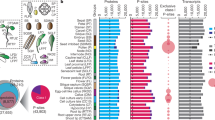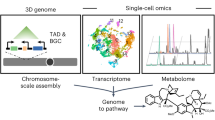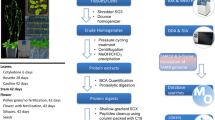Abstract
Multiparallel analyses of mRNA and proteins are central to today's functional genomics initiatives. We describe here the use of metabolite profiling as a new tool for a comparative display of gene function. It has the potential not only to provide deeper insight into complex regulatory processes but also to determine phenotype directly. Using gas chromatography/mass spectrometry (GC/MS), we automatically quantified 326 distinct compounds from Arabidopsis thaliana leaf extracts. It was possible to assign a chemical structure to approximately half of these compounds. Comparison of four Arabidopsis genotypes (two homozygous ecotypes and a mutant of each ecotype) showed that each genotype possesses a distinct metabolic profile. Data mining tools such as principal component analysis enabled the assignment of “metabolic phenotypes” using these large data sets. The metabolic phenotypes of the two ecotypes were more divergent than were the metabolic phenotypes of the single-loci mutant and their parental ecotypes. These results demonstrate the use of metabolite profiling as a tool to significantly extend and enhance the power of existing functional genomics approaches.
This is a preview of subscription content, access via your institution
Access options
Subscribe to this journal
Receive 12 print issues and online access
$209.00 per year
only $17.42 per issue
Buy this article
- Purchase on Springer Link
- Instant access to full article PDF
Prices may be subject to local taxes which are calculated during checkout





Similar content being viewed by others
References
Somerville, C. & Somerville, S. Plant functional genomics. Science 285, 380– 383 (1999).
Baldwin, D., Crane, V. & Rice, D. A comparison of gel-based, nylon filter and microarray techniques to detect differential RNA expression in plants. Curr. Opin. Plant Biol. 2, 96–103 (1999).
Santoni, V. et al. Use of a proteome strategy for tagging proteins present at the plasma membrane. Plant J. 16, 633– 641 (1998).
Trethewey, R.N., Krotzky, A.J. & Willmitzer, L. Metabolic profiling: a Rosetta stone for genomics? Curr. Opin. Plant Biol. 2, 83– 85 (1999).
Katona, Z.F., Sass, P. & Molnár-Perl, I. Simultaneous determination of sugars, sugar alcohols, acids and amino acids in apricots by gas chromatography–mass spectrometry . J. Chromatogr. A 847, 91– 102 (1999).
Adams, M.A., Chen, Z.L., Landman, P. & Colmer, T.D. Simultaneous determination by capillary gas chromatography of organic acids, sugars, and sugar alcohols in plant tissue extracts as their trimethylsilyl derivatives . Anal. Biochem. 266, 77– 84 (1999).
Duez, P., Kumps, A. & Mardens, Y. GC–MS profiling of urinary organic acids evaluated as a quantitative method. Clin. Chem. 42, 1609–1615 (1996).
Fiehn, O., Kopka, J., Trethewey, R.N. & Willmitzer, L. Identification of uncommon plant metabolites based on calculation of elemental compositions using gas chromatography and quadrupole mass spectrometry. Anal. Chem. 72, 3573–3580 (2000).
McLafferty, F.W., Stauffer, D.A., Loh, S.Y. & Wesdemiotis, C. Unknown identification using reference mass spectra. Quality evaluation of databases J. Am. Soc. Mass Spectrom. 10, 1229–1240 (1999)
Metabolite profiling (Max Planck Institute of Molecular Plant Physiology). http://www.mpimp-golm.mpg.de/fiehn/index-e.html.
Gygi, S.P. et al. Quantitative analysis of complex protein mixtures using isotope-coded affinity tags Nat. Biotechnol. 17, 994– 999 (1999).
Vingron, M. & Hoheisel, J. Computation aspects of expression data J. Mol. Med. 77, 3– 7 (1999).
Dörmann, P., Hoffmann-Benning, S., Balbo, I. & Benning, C. Isolation and characterization of an Arabidopsis mutant deficient in the thylakoid lipid digalactosyl diacylglycerol. Plant Cell 7, 1801–1810 (1995).
Härtel, H., Lokstein, H., Dörmann, P., Trethewey, R.N. & Benning, C. Photosynthetic light utilization and xantophyll cycle activity in the galactolipid deficient dgd1 mutant of Arabidopsis thaliana. Plant Physiol. Biochem. 36, 407–417 ( 1998).
Dörmann, P., Balbo, I. & Benning, C. Arabidopsis galactolipid biosynthesis and lipid trafficking mediated by DGD1 Science 284, 2181–2184 (1999).
Berger, D. & Altmann, T. A subtilisin-like serine protease involved in the regulation of stomatal density and distribution in Arabidopsis thaliana. Gene Dev. 14, 1119–1131 (2000).
Mead, R., Curnow, R.N. & Hasted, A.M. (eds). Statistical methods in agriculture and experimental biology, Edn. 2. (Chapman & Hall, London; 1993).
Murakami, Y., Tsuyama, M., Kobayashi, Y., Kodama, H. & Iba, K. Trienoic fatty acid and plant tolerance of high temperature. Science 287, 476– 479 (2000).
GenomeNet database. (Institute for Chemical Research, Kyoto University, Japan). http://www.genome.ad.jp/
What Is There? Interactive metabolic reconstruction on the WEB. (Argonne Computational Biology Group, Chicago, IL). http://wit.mcs.anl.gov/WIT2/
Zweiger, G. Knowledge discovery in gene-expression-microarray data: mining the information output of the genome. Trends Biotechnol. 17, 429–436 (1999).
Jurs, P.C. Pattern recognition used to investigate multivariate data in analytical chemistry . Science 232, 1219 ( 1986).
Acknowledgements
This project was funded by the Max-Planck-Society. We thank Frank Kose, Una Griebel, and Antje Feller for their support in carrying out laboratory and computer work, Urte Schlüter for providing C24 WT and sdd1-1 mutant plants, and Megan McKenzie for revising the manuscript.
Author information
Authors and Affiliations
Corresponding author
Rights and permissions
About this article
Cite this article
Fiehn, O., Kopka, J., Dörmann, P. et al. Metabolite profiling for plant functional genomics. Nat Biotechnol 18, 1157–1161 (2000). https://doi.org/10.1038/81137
Received:
Accepted:
Issue Date:
DOI: https://doi.org/10.1038/81137
This article is cited by
-
Integrated transcriptomic and metabolomic analysis reveals the effects of polyploidization on the lignin content and metabolic pathway in Eucalyptus
Biotechnology for Biofuels and Bioproducts (2023)
-
Morphology, growth, and metabolomics mass profiling of the marine diatom Nitzschia acicularis (Kutzing) W. Smith isolate CSIRCSMCRI 008
Biomass Conversion and Biorefinery (2023)
-
5-Azacytidine affects gene expression and metabolic profile of Pinus elliottii x Pinus caribaea var. hondurensis embryogenic cell lines
Plant Cell, Tissue and Organ Culture (PCTOC) (2023)
-
Identification of Bioactive Pentacyclic Triterpenoids and Fatty Acid Derivatives from Cissus quadrangularis and C. rotundifolia Through Untargeted Metabolite Profiling
Applied Biochemistry and Biotechnology (2023)
-
The potential of metabolomics in assessing global compositional changes resulting from the application of CRISPR/Cas9 technologies
Transgenic Research (2023)



